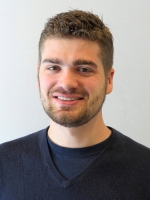Peter Kraus
Vrije Universiteit (VU) Amsterdam, Advanced Research Center for Nanolithography (ARCNL), Netherlands
Towards ultrafast imaging of correlated matter with transient high-harmonic generation
When: 12:00-13:00 CET, October 1st (Tuesday), 2024
Where: Main Hall, ICMM-CSIC, Campus de Cantoblanco, Madrid
The highly complex collective electron-dynamics in strongly correlated materials mandates experimental techniques with sub-fs temporal and nanometer spatial resolution. While a plethora of techniques exists, true nanometer imaging on fs or even sub-fs timescales remains elusive. Such techniques are required to follow the collective dynamics of electrons in strongly correlated materials in real time, which drive ultrafast phase transitions that are accompanied by technologically relevant order-of-magnitude resistivity switches.
High-harmonic generation (HHG) in solids has emerged 14 years ago. Gas-phase HHG is highly sensitive and thus optically controllable with regards to the microscopic generation
mechanism. The parallels between solid and gas-phase HHG suggest that solid-state HHG may be controlled in a similar manner, which enables a generally applicable all-optical light switch with wide application potential. The current literature on transient solid-state HHG confirms this opportunity of all-optical control of solid HHG [1]. In this talk, I will present our vision to use this light switch for sub-fs super-resolution nanoscale imaging by HHG from correlated materials. In particular, I will present three key experiments on our roadmap towards this goal.
On the nanoscale, we controlled HHG via engineering the surface topography of solids, which in turn demonstrates how solid HHG can be used for metrology on surfaces and tailored as a light source [2-4].
On the femtosecond time scale, we used the sensitivity of HHG to electronic band structure to follow ultrafast phase transitions in strongly correlated materials [5], and photocarrier dynamics in perovskites [6]. While the first measurements [2] showed nanoscale sensitivity, the second set of experiments [5,6] demonstrated that photoexcitation can be used to control light emission via solid HHG.
Combining both efforts, I will show first results how ultrafast control of solid HHG enables
HArmonic DEactivation microScopy (HADES) – a label-free super-resolution microscopy
below the diffraction limit of light [7]. Thinking ahead, the development of these techniques may enable resolution on the nanometer and femto- to attosecond scale fitted into a regular microscopy setting, with application potential ranging from strongly correlated materials to semiconductor metrology, photosynthetic processes, and medical imaging.
References:
[1] P. v. Essen, Z. Nie, B. de Keijzer, P.M. Kraus, arXiv:2402.15375, ACS Photonics, accepted (2024).
[2] S.D.C. Roscam Abbing, R. Kolkowski, Z.-Y. Zhang, F. Campi, L. Loetgering, A.F. Koenderink, P.M. Kraus,
Physical Review Letters 128, 223902 (2022).
[3] P. M. Kraus et al., US Patent App. 18/038,590 (2024).
[4] P. M. Kraus et al., US Patent App. 18/253,734 (2024).
[5] Z. Nie et al., Peter M. Kraus, Physical Review Letters, 131, 243201 (2023).
[6] M. v.d. Geest, J.J. de Boer, K. Murzyn, P. Juergens, B. Ehrler, P.M. Kraus, Journal of Phys. Chem. Lett., 14, 10810 (2023).
[7] K. Murzyn, M.v.d. Geest, L. Guery, Z. Nie, P.v. Essen, S. Witte, P.M. Kraus, arXiv:2403.06617, submitted (2024).


